

Information technology. Information technology (IT) is the application of computers and telecommunications equipment to store, retrieve, transmit and manipulate data,[1] often in the context of a business or other enterprise.[2] The term is commonly used as a synonym for computers and computer networks, but it also encompasses other information distribution technologies such as television and telephones.
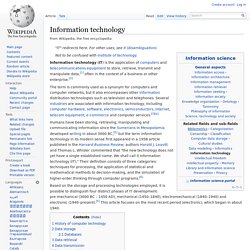
Several industries are associated with information technology, including computer hardware, software, electronics, semiconductors, internet, telecom equipment, e-commerce and computer services.[3][a] Humans have been storing, retrieving, manipulating and communicating information since the Sumerians in Mesopotamia developed writing in about 3000 BC,[5] but the term information technology in its modern sense first appeared in a 1958 article published in the Harvard Business Review; authors Harold J. Leavitt and Thomas L. Whisler commented that "the new technology does not yet have a single established name.
Main Page - FISMApedia. Category:CNSSI 4009 Terms - FISMApedia. Open data. An introductory overview of Linked Open Data in the context of cultural institutions.

Clear labeling of the licensing terms is a key component of Open data, and icons like the one pictured here are being used for that purpose. Overview[edit] The concept of open data is not new; but a formalized definition is relatively new—the primary such formalization being that in the Open Definition which can be summarized in the statement that "A piece of data is open if anyone is free to use, reuse, and redistribute it — subject only, at most, to the requirement to attribute and/or share-alike.
"[2] The BBC's Dynamic Semantic Publishing Showcase. By using Ontotext technology, the BBC has achieved dynamic metadata-driven semantic publishing for their FIFA 2010 World Cup Web site, as described in Jem Rayfield's SemTech 2011 presentation.
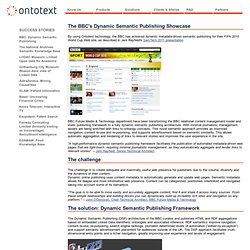
BBC Future Media & Technology department have been transforming the BBC relational content management model and static publishing framework to a fully dynamic semantic publishing architecture. With minimal journalistic management, assets are being enriched with links to ontology concepts. This novel semantic approach provides an improved navigation, content re-use and re-purposing, and supports advertisement based on semantic similarity. This allows automatic aggregation and rendering of links to relevant stories and improves the user experience in the site. The challenge is to create adequate and maximally useful web presence for publishers due to the volume, diversity and the dynamics of their content.
. … The index pages are published automatically. World Cup 2010. Open science data. Open science data is a type of open data focused on publishing observations and results of scientific activities available for anyone to analyze and reuse.
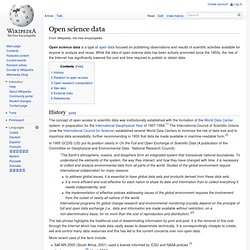
While the idea of open science data has been actively promoted since the 1950s, the rise of the Internet has significantly lowered the cost and time required to publish or obtain data. History[edit] Open Data Challenge. Open Government Data. The World Bank. Data.gov.au. Open Data - Open Data Pilot Project - Home. Opening up government. Legal tools for Open Data. BioPAX.org. Helsinki Region Infoshare. OS OpenData - Ordnance Survey.
OS OpenData™ offers a wide range of digital map products which you can freely view or download, for use in both personal and commercial applications.
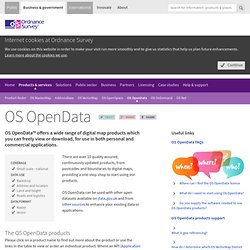
Coverage Small scale - national Data use Backdrop Address and location Land and height Roads and logistics Data format Raster Vector There are over 10 quality assured, continuously updated products, from postcodes and boundaries to digital maps, providing a one-stop shop to start using our products.
OS OpenData can be used with other open datasets available on data.gov.uk and from other sources to enhance your existing data or applications. The OS OpenData products Please click on a product name to find out more about the product or use the links in the table to view or order an individual product. Share your ideas Why not discuss your ideas or questions with other customers on the OS OpenData forum.
The Open Data Manual — Open Data Manual v2.0alpha documentation. Linked Open Data in Finland - Semantic Computing Research Group (SeCo) Vaalilupausarkisto. Tarinahaku. Etusivu. Linked Open Data in Finland - Semantic Computing Research Group (SeCo) Perjantai 26.3.2010, Aalto-yliopisto, TUAS-talo, sali AS2, klo 9:00-12:15 Tiedon arvo kasvaa sitä avoimesti verkossa julkaisemalla ja yhdistelemällä!

Puhujina mm. ministeri Suvi Lindén, toimitusjohtaja Mikael Jungner, Sitran kehitysjohtaja Ossi Kuittinen ja muita alan asiantuntijoita. Lehdistötiedote Esitelmien kalvot ja muistiinpanot: Ohjelma ja julkistukset Ohjelmassa esitellään avoimen tiedon ja yhdistetyn tiedon mahdollisuuksia, periaatteita, merkitystä ja tekniikkaa näkökulmina tietoyhteiskunnat tarpeet, valtiotason tietoarkkitehtuurit, innovaatiotoiminta, elinkeinoelämä sekä uudet web-teknologiat. Tilaisuudessa julkistetaan semanttisen webin FinnONTO-hankkeen uusi laaja jatkovaihe FinnONTO 2.0 (2010-2012), kerrotaan kansallisesta valtiotason tietoarkkitehtuurit -hankkeesta ja esitellään uusi liikenne- ja viestintäministeriön raportti tiedon avaajille. Helsinki Region Infoshare. Forum Virium Helsinki. Where to Find Open Data on the Web. Today, a story on Techmeme caught our eye.
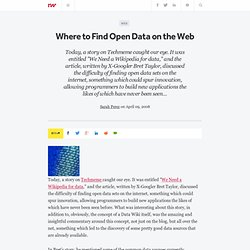
It was entitled "We Need a Wikipedia for data," and the article, written by X-Googler Bret Taylor, discussed the difficulty of finding open data sets on the internet, something which could spur innovation, allowing programmers to build new applications the likes of which have never been seen before. What was interesting about this story, in addition to, obviously, the concept of a Data Wiki itself, was the amazing and insightful commentary around this concept, not just on the blog, but all over the net, something which led to the discovery of some pretty good data sources that are already available. In Bret's story, he mentioned some of the common data sources currently available, like the US Census Bureau's map data and the Reuters corpus, but his commenters came up with a few more. (See? This is why blog comments matter). In addition, as CNet and Ryan Stewart's blog spread the story, more people chimed in with suggestions.
Infochimps.org Jigsaw. The Open Data Foundation. Finnish Open Data Ecosystem. Open Data Kit. Open Data builds predictive models over big data. Datajournalismin päivä 29.9. Tampereella. Patenting VisiCalc. Why didn't we patent the spreadsheet?
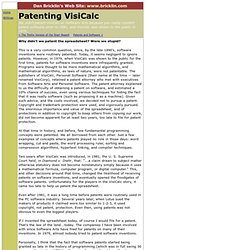
Were we stupid? This is a very common question, since, by the late 1990's, software inventions were routinely patented. Today, it seems negligent to ignore patents. However, in 1979, when VisiCalc was shown to the public for the first time, patents for software inventions were infrequently granted.